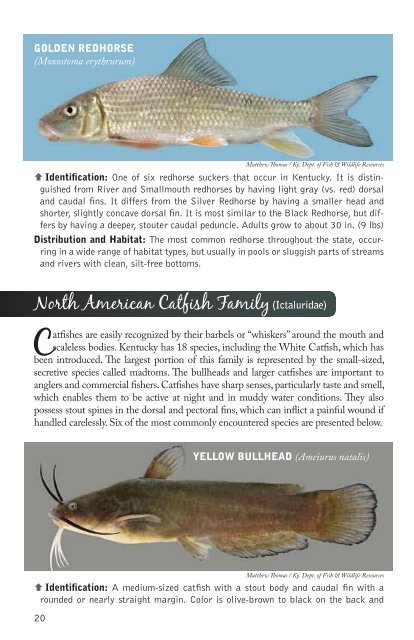Kentucky Fishes
kyfishid[1]
kyfishid[1]
- No tags were found...
You also want an ePaper? Increase the reach of your titles
YUMPU automatically turns print PDFs into web optimized ePapers that Google loves.
GOLDEN REDHORSE<br />
(Moxostoma erythrurum)<br />
sides, grading to pale yellow or white on the belly. It is most similar to the Black<br />
Bullhead, but differs by having white or pale yellow (vs. black) chin barbels and anal<br />
fin with a straight (vs. rounded) margin. Adults grow to about 18 in. (4 lbs).<br />
Distribution and Habitat: Common statewide in a variety of habitats, but most frequently<br />
found in pools or sluggish backwaters of streams and reservoirs over soft<br />
bottoms with accumulated debris.<br />
BLUE CATFISH<br />
(Ictalurus furcatus)<br />
Matthew Thomas / Ky. Dept. of Fish & Wildlife Resources<br />
Ç Identification: One of six redhorse suckers that occur in <strong>Kentucky</strong>. It is distinguished<br />
from River and Smallmouth redhorses by having light gray (vs. red) dorsal<br />
and caudal fins. It differs from the Silver Redhorse by having a smaller head and<br />
shorter, slightly concave dorsal fin. It is most similar to the Black Redhorse, but differs<br />
by having a deeper, stouter caudal peduncle. Adults grow to about 30 in. (9 lbs)<br />
Distribution and Habitat: The most common redhorse throughout the state, occurring<br />
in a wide range of habitat types, but usually in pools or sluggish parts of streams<br />
and rivers with clean, silt-free bottoms.<br />
North American Catfish Family (Ictaluridae)<br />
Catfishes are easily recognized by their barbels or “whiskers” around the mouth and<br />
scaleless bodies. <strong>Kentucky</strong> has 18 species, including the White Catfish, which has<br />
been introduced. The largest portion of this family is represented by the small-sized,<br />
secretive species called madtoms. The bullheads and larger catfishes are important to<br />
anglers and commercial fishers. Catfishes have sharp senses, particularly taste and smell,<br />
which enables them to be active at night and in muddy water conditions. They also<br />
possess stout spines in the dorsal and pectoral fins, which can inflict a painful wound if<br />
handled carelessly. Six of the most commonly encountered species are presented below.<br />
Matthew Thomas / Ky. Dept. of Fish & Wildlife Resources<br />
Ç Identification: A large, heavy-bodied catfish with a deeply-forked caudal fin. Color<br />
is pale blue to gray on the back and sides, fading to white on the lower sides and belly.<br />
It is similar to the Channel Catfish, but differs by having a long, straight-edged (vs.<br />
shorter, rounded) anal fin and no dark spots on the body. Adults can grow to about 5.5<br />
ft. (150 lbs), but individuals ranging from 20-50 in. (3-60 lbs) are most common.<br />
Distribution and Habitat: Occurs in main channels, backwaters, and embayments of<br />
the Ohio and Mississippi rivers, lower reaches of their major tributaries, as well as<br />
open waters of large reservoirs. The Blue Catfish is stocked as a sport fish in several<br />
reservoirs in central and western <strong>Kentucky</strong>.<br />
CHANNEL CATFISH<br />
(Ictalurus punctatus)<br />
YELLOW BULLHEAD (Ameiurus natalis)<br />
Matthew Thomas / Ky. Dept. of Fish & Wildlife Resources<br />
Ç Identification: A medium-sized catfish with a stout body and caudal fin with a<br />
rounded or nearly straight margin. Color is olive-brown to black on the back and<br />
Matthew Thomas / Ky. Dept. of Fish & Wildlife Resources<br />
Ç Identification: A long, slender-bodied catfish with a deeply-forked caudal fin.<br />
Color is olive to pale gray on the back and sides, often with small black spots, and<br />
a white belly. It is similar to the Blue Catfish, but differs by having a rounded (vs.<br />
straight) anal fin margin and dark spots on the sides of the body (vs. spots absent).<br />
Adults can grow to about 4 ft. (60 lbs), but typically range from 12-32 in. (1-15 lbs).<br />
Distribution and Habitat: Common statewide in medium-sized streams to large rivers,<br />
but adaptable to a variety of habitats. Valued as a sport and food fish, the Channel<br />
Catfish is routinely stocked in ponds and reservoirs throughout the state.<br />
20 21



